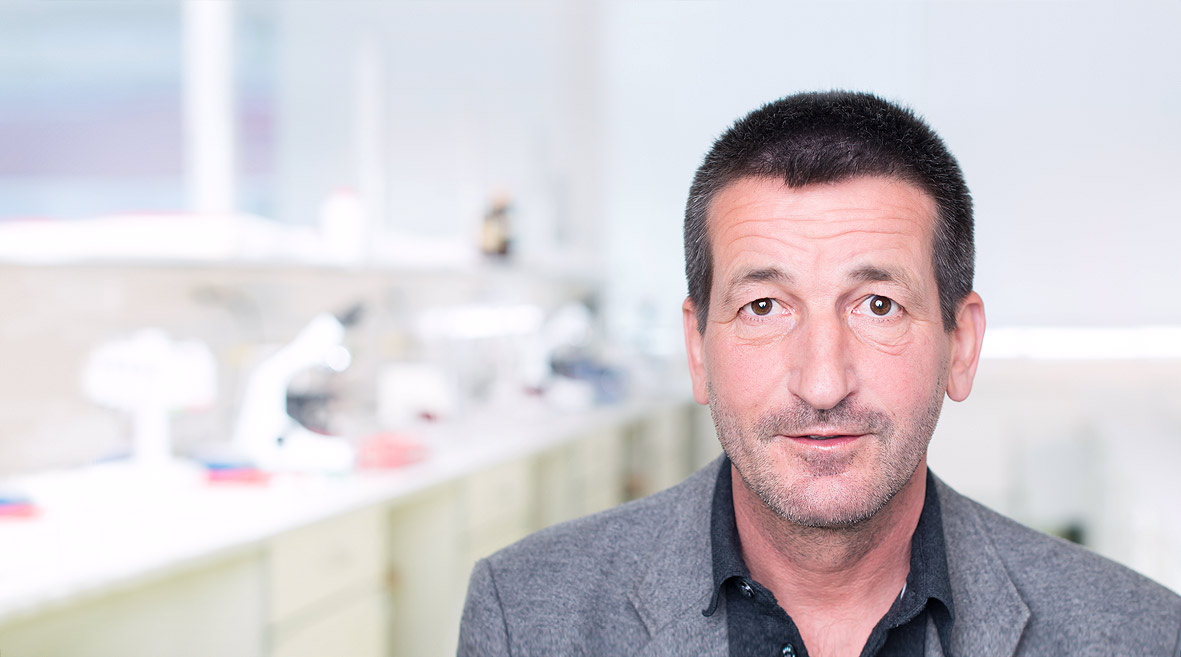Ao.Univ.-Prof.Dr.rer.nat.
In this regard he is studying the involvement of complement in multi-faced effector functions of the immune system such as viral trapping in the germinal center, phagocytosis, complement-mediated lysis (CML) or effects of anaphylatoxins and counter measurements of viruses to escape these complement-driven immune responses.
RECENT PROJECTS:
Recent projects of the Stoiber group had two focuses (i) identification of viral protection mechanisms against CML and specific induction of virolysis and (ii) involvement of complement in antigen-presentation and subsequent induction of virus-specific cytotoxic T cell (CTL) responses. Their findings that retroviruses are protected against CML by the acquisition of membrane-anchored regulators of complement activation (RCAs), such as CD59 or CD55, and the additional binding of fluid phase RCAs, such as factor H (fH), they developed constructs which aimed to inhibit the RCA function specifically on surface of retroviruses or virus-infected cells (unpublished observation). These investigations were extended to bacteria (P. aerugenosa) or tumour cells (chronic lymphatic leukaemia) all of which have protection mechanisms against CML similar as retroviruses (unpublished observation). Recently they and others showed that not only retroviruses but also Hepatitis C virus (HCV) is at least partially protected against CML by the acquisition and in-corporation of CD59. Previous studies from the group demonstrated that the deposition of complement proteins and/or specific antibodies on the surface of pathogens have an impact on antigen presentation by dendritic cells. Complement turned out as natural adjuvant for the induction of retrovirus-specific CTLs.
COLLABORATIONS:
Strong collaborations with the groups of:
Würzner, Grubeck-Loebenstein
Kapferer-Seebacher I, Pepin M, Werner R, Aitman T, Nordgren A, Stoiber H, Thielens N, Gaboriaud C, Amberger A, Schossig A, Gruber R, Giunta C, Bamshad M, Björck E, Chen C, Chitayat D, , Dorschner M, Schmitt-Egenolf M, Hale JC, Hanna D, Hennies HC, Heiss-Kisielewsky I, Lindstrand A, Lundberg P, Mitchell AL, Nickerson D, Reinstein E, Rohrbach M, Romani N, Schmuth M, Silver R, Taylan F, Vandersteen A, Vandrovcova J, Weerakkody R, Yang M, Pope FM, the Consortium “Molecular Basis of Periodontal EDS”, Byers P, Zschocke J. Periodontal Ehlers-Danlos syndrome is caused by mutations in C1R and C1S, which encode subcomponents C1r and C1s of complement. Am J Hum Genet 99(5):1005-1014. doi: 10.1016/j.ajhg.2016.08.019 (2016).
Price PJ, Bánki Z, Scheideler A, Stoiber H, Verschoor A, Sutter G, Lehmann MH. Complement component C5 recruits neutrophils in the absence of C3 during respiratory infection with modified vaccinia virus Ankara. J Immunol 194(3): 1164-8 (2015).
Reynoso R, Laufer N, Hackl M, Skalicky S, Monteforte R, Turk G, Carobene M, Quarleri J, Cahn P, Werner R, Stoiber H, Grillari-Voglauer R, Grillari J. MicroRNAs differentially present in the plasma of HIV elite controllers reduce HIV infection in vitro. Sci Rep 4: 5915 (2014).
Hörl S, Banki Z, Huber G, Ejaz A, Müllauer B, Willenbach E, Steurer M, Stoiber H. Reduction of complement factor H binding to CLL cells improves the induction of rituximab-mediated complement-dependent cytotoxicity. Leukemia 27(11): 2200-8 (2013).
Hörl S, Banki Z, Huber G, Ejaz A, Müllauer B, Willenbacher E, Steurer M, Stoiber H. Complement factor H-derived short consensus repeat 18-20 enhanced complement-dependent cytotoxicity of ofatumumab on chronic lymphocytic leukemia cells. Haematologica 98(12): 1939-47 (2013).
Pfaender S, Heyden J, Friesland M, Ciesek S, Ejaz A, Steinmann J, Steinmann J, Malarski A, Stoiber H, Tsiavaliaris G, Bader W, Jahreis G, Pietschmann T, Steinmann E. Inactivation of hepatitis C virus infectivity by human breast milk. J Infect Dis 208(12): 1943-52 (2013).
PROGRAMME SPEAKER
Reinhard Würzner, M.D., Ph.D.
Schöpfstraße 41
A-6020 Innsbruck
horos@i-med.ac.at
Imprint







